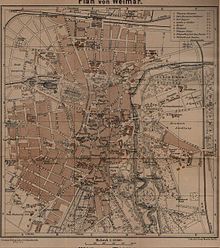Weimar tram
The Weimar tram served inner-city traffic in the then state capital of the Grand Duchy of Saxony-Weimar-Eisenach from 1899 to 1937 and of the Free State of Thuringia since 1920.
Weimar electric tram

The city administration of Weimar signed a contract with Siemens & Halske AG in Berlin on December 6, 1897 , in which the electricity company undertook to build a tram and an electrical works in Weimar. After its completion, the "Electrische Straßenbahn Weimar" became the property of "Siemens" Elektro Betriebe AG in Berlin.
The first 3.25 km long tram line opened on June 4, 1899. It led from Weimar train station in the north via Sophienstraße to the city center and via Belvederer Allee to the south to the Falkenburg excursion restaurant. In the city center, between the post office and Wielandplatz, both via Karlsplatz - Erfurter Tor and via Graben - Markt. A service track branched off from the museum to the depot on Kirschberg.
A second line was added in 1908; it connected the state train station via the post office and Erfurter Straße with the Berka train station and led in a large arc over Junkerstraße to Wielandplatz, where it ended after 3.2 kilometers and connected to the main line.
This got a red signal, while that of the new line was green. It was not until December 31, 1930 that these colors were replaced by line numbers 1 and 2.
Weimar city tram
On October 1, 1920, the city of Weimar took over the tram and operated it through the municipal works. Despite the difficult economic situation, which forced a standstill for months between 1923 and 1924, attempts were made to further improve traffic. For this purpose, ten new railcars were procured from 1926 to 1928 to replace the previous fleet.
As early as 1929 there were attempts to replace the tram with buses. At first, the bus operation was still unprofitable, so that the tram operation was not stopped until June 30, 1937. The relatively new railcars were sold to the tram in Jena.
The planned conversion to electric trolleybuses could not be carried out at short notice. Therefore, from July 1, 1937, two urban bus routes were used, which were expanded by a third after just one month. The line network of 15.1 kilometers in length was served by nine buses.
The Weimar trolleybus was only opened on February 2, 1948. Weimar is currently the largest city without a tram network in the five eastern German states.
literature
- The trams in the GDR, Berlin 1978, ISBN 3-87943-625-8
- Tram and trolleybus in Weimar, in the tram magazine No. 104 (issue 1996/6)

